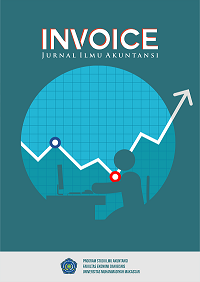Implementation, Control Of Management Audit On The Performance Of The Regional Drinking Water Company (PDAM) Palopo City
DOI:
https://doi.org/10.26618/inv.v4i2.9000Abstract
Implementation of Management Audit at Regional Water Company (PDAM) Palopo City This research was conducted in order to find out how the management audit process at PDAM Palopo City. This research was carried out using a descriptive analysis case study method, which is a method that collects, presents and analyzes. The collection of research material is carried out by taking financial data and distributing questionnaires so that it will obtain a fairly clear picture of an object under study. From the research that was faced by the author, there were not a few obstacles the author got, including data access and free time for interviews. The research results obtained are as follows; The planning managed by the company has been effective, but in operating control it is seen that it still needs careful evaluation. Productivity has been adequate in distributing raw materials in the form of water seeds and has met service standards. The level of inventory or reserves has been adequate but in the consumer service sector it is still considered less than optimal so it is recommended for company management to evaluate it as an internal control. The most sensitive thing is in the budget or financial sector. The results were less than optimal, especially in the income sector which decreased compared to last year.
References
Agoes, Sukrisno. 2017. Auditing : Petunjuk Peraktis Pemeriksaan Akuntan oleh Akuntansi Publik, Edisi 4. Jakarta: Salemba Empat.
Agoes, Sukrisno. 2019. Auditing oleh kantor akuntansi publik, jilid 1 dan 2.
Jakarta: Lembaga Penerbit Fakultas Ekonomi Universitas Indonesia.
Arens, Dkk. 2004. Auditing dan Pelayanan Verifikasi, Edisi 9 jilid 1 dan 2. New Jersey: Prentice Hall Inc.
Arikunto, Suharsimi dkk. 2010. Penelitian Tindakan Kelas. Jakarta: Bumi Aksara.
Astuti, Amelia Umi. 2008. Skripsi: “Audit Operasional untuk Menilai Efektivitas dan Efisiensi Fungsi Pemasaran Studi Kasus pada PT. Asuransi Jasa Indonesia (Persero) Kantor Cabang Malang”. Fakultas Ekonomi dan Bisnis Universitas Brawijaya.
Bhayangkara, IBK., 2018. Audit Manajemen Prosedur dan Implementasi. Jakarta: Salemba Empat.
Elfira (2011) dengan Judul Penelitian“ Penerapan Audit Manajemen Keuangan Pada PT. Tirta Makna Bahagia Makassar”. Fakultas Ekonomi Universitas Muslim Indonesia
Indriantoro, Nur dan Soepomo B. 1999. Metodologi Penelitian Bisnis. Yogyakarta: BPFE-Yogyakarta.
Kotler, Philip dan Gary Amstrong. 2008. Marketing an Introduction. New Jersey: Prentice Hall Inc. diterjemahkan oleh Nurmawan, Iwan SE. Prinsip-prinsip Pemasaran, Edisi 12, jilid 1 dan 2. Jakarta: Erlangga.
Kotler, dan Amstrong. 2012. Manajemen Pemasaran, Edisi 12, Jilid 1. Penerbit Indeks.
Mulyadi. 2013. Auditing Jilid 1, Edisi 6. Jakarta: Salemba Empat.
Oktaviani, Aurelia Oky. 2011. Skripsi: “Audit Operasional Fungsi Pemasaran sebagai Upaya Penilaian Efisiensi dan Efektivitas pada Bank Tabungan Pensiunan Nasional Cabang Malang”. Fakultas Ekonomi dan Bisnis Universitas Brawijaya.
Rispiani. 2012. Skripsi: “Analisis Audit Manajemen atas Fungsi Pemasaran pada PT. Pertamina Persero Unit Pemasaran VII di Makassar”. Fakultas Ekonomi Universitas Hasanuddin.
Sekaran, Uma. 2011. Research Methods for Business, 4 Edition. New York: John Wiley & Sons Inc. diterjemahkan oleh Yon, Kwan Men. 2006. Metodologi Penelitian untuk Bisnis. Edisi 4. Jakarta: Salemba Empat. Siagian, Sondang. 1997. Audit Manajemen. Jakarta: Bumi Aksara.
Siagian, Sondang P. (2001 ). Manajemen Sumber Daya Manusia. Bumi Aksara,Jakarta.
Sugiyono. 2009. Metode Penelitian Kuantitatif dan Kualitatif. Bandung: CV. Alfabeta.
Tunggal, Amin Widjaja. 2003. Audit Manajemen Kontemporer. Jakarta: Harvarindo
Downloads
Published
Issue
Section
License
Authors who publish with Invoice: Jurnal Ilmu Akuntansi agree to the following terms:
Copyright Ownership
The copyright of all articles published in this journal remains with the author(s). However, the authors grant Invoice: Jurnal Ilmu Akuntansi the right of first publication with the work simultaneously licensed under a Creative Commons Attribution 4.0 International License (CC BY 4.0). This license allows others to share, copy, redistribute, adapt, and build upon the work for any purpose, even commercially, as long as proper credit is given to the original author(s) and the source.Licensing and Access
Invoice: Jurnal Ilmu Akuntansi provides immediate open access to its content on the principle that making research freely available to the public supports a greater global exchange of knowledge. All published materials are available freely without subscription or payment and can be accessed, downloaded, and reused by any user provided that appropriate attribution is given.Permission for Reuse
For uses not covered by the CC BY 4.0 license, such as commercial reprints, translations, or any form of adaptation without clear attribution, users must obtain written permission from the editorial team. Requests for such permissions can be directed to the editorial office at: [insert journal email here].Plagiarism and Originality
Authors are responsible for the originality of their submissions. All articles are screened for plagiarism using appropriate tools before acceptance. Manuscripts found to contain unoriginal content or infringing materials will be rejected or retracted as per journal policy.

